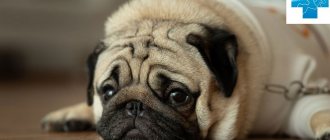Dogs have a delicate and sensitive digestive system that reacts strongly to any changes - to poor quality food, sudden changes in food, to a bone with dirt that the animal can pick up on the street, as well as to the ingestion of a foreign body.
As a result, unpleasant symptoms may appear, including bloody discharge in the stool. If your dog has bloody diarrhea, then in these cases you should immediately contact a veterinarian so that he can conduct an examination and determine the cause of this sign.
Causes of diarrhea in dogs
Just like in humans, diarrhea in dogs can be a manifestation of a variety of diseases.
Of course, the most common and obvious cause of indigestion is food poisoning or another malfunction of the digestive system. Due to the powerful bactericidal properties of saliva, dogs are less sensitive than other pets (particularly cats) to low-quality or stale food. Moreover, in the wild, the closest relatives of dogs, foxes and jackals (1), are generally able to feed on carrion, but it is worth understanding that most domestic dogs have gone so far from their wild ancestors that they have long ago lost all these talents. Their body has become as sensitive to food as ours. And the first reaction to any problem in the body is diarrhea or, more simply, diarrhea. There are also many breeds that are particularly demanding on the quality and type of food (for example, Chihuahuas), the same applies to white dogs, most of which are allergic.
But it should be understood that malnutrition is far from the only cause of diarrhea, and sometimes we can talk about really serious diseases, such as enteritis, hepatitis, helminthiases, the gastric form of distemper - officially this disease is called carnivore distemper (2) and others. Also, diarrhea in dogs can be a symptom of other ailments that at first glance are not related to nutrition.
“If you notice diarrhea in a dog, we always recommend seeing a veterinarian,” says veterinarian Ruslan Shadrin, “because what manifests itself as a disorder of the gastrointestinal tract does not always relate directly to it, it may be a secondary manifestation of some then another disease. And if it is viral, then it is quite serious, and the owner, unfortunately, will not help here in any way. Also, many diseases not related to digestion can manifest themselves in the form of diarrhea. This is primarily kidney damage. When toxins are not eliminated in sufficient quantities in the usual way, the body gets rid of them where it can: through the skin, through the mucous membranes, resulting in irritation and inflammation. These may also be problems of a cardiac nature: disturbances in blood pressure due to the work of the heart can also manifest themselves as various dyspeptic disorders. Also, the cause may be problems with the central nervous system, since the control of internal organs by the brain is disrupted. We can also talk about problems of organs that are associated with the digestive tract, but function outside it, for example, the liver. As a result, both the endocrine and exocrine systems of the animal’s body suffer.
Therefore, if you notice that your dog has been suffering from an upset stomach for more than a day, be sure to contact your veterinarian.
Symptoms of the disease
The presence of blood clots and inclusions in the feces of a four-legged friend is a pathological process that may indicate problems in the body.
Note! Frequent stools with blood and mucus may indicate the presence of serious disturbances in the functioning of the digestive system in the animal.
Also, bloody diarrhea may indicate the development of acute viral-bacterial, parasitic diseases and infections.
If your dog exhibits symptoms from the list below, you should immediately contact your veterinarian:
- the animal has prolonged profuse diarrhea, which can last more than two days;
- an unpleasant fetid odor emanates from the stool;
- the animal experiences vomiting and nausea;
- decreased appetite;
- the dog completely refuses to eat food and drink water;
- increase in body temperature by 1-2 degrees;
- yellowing, anemia of the mucous membranes;
- the dog vomits, it becomes lethargic and drowsy;
- manifestation of inadequate reactions to external stimuli.
If your dog has diarrhea with mucus and blood, then you should not self-medicate. Be sure to immediately contact a veterinarian. The doctor will be able to identify the underlying cause of this symptom, and he will prescribe the appropriate treatment.
Classification of diarrhea in dogs
Photo: Tima Miroshnichenko, pexels.com
No matter how unappetizing it may sound, but if you notice that your four-legged friend is moving differently than usual, pay attention to the nature of the stool.
If the only deviation from the norm is its consistency - it is more liquid than usual, then the reason for this is most likely a change in diet: either you recently switched the dog to a different type of food, or treated it to something unusual for it. In a word, the food did not go to waste. Draw conclusions and don’t experiment anymore.
However, if the feces have changed not only the consistency, but also the color or they contain mucus, you should be wary. They can be yellow, black, green and completely watery, and sometimes contain an admixture of blood. And here it’s worth contacting a specialist.
It is also necessary to distinguish between temporary diarrhea due to accidentally eaten low-quality food and chronic diarrhea that occurs against the background of more serious diseases.
Bloody diarrhea
If you notice that your four-legged friend is bleeding heavily, this is a reason to sound the alarm. As a rule, such manifestations signal serious disturbances in the functioning of the dog’s body.
The cause may be severe poisoning, and we are no longer talking about stale food - most likely, your dog has swallowed real poison. Also, bloody diarrhea in dogs, and especially in puppies, is a consequence of infection with an enterovirus. And here it is very important to provide timely veterinary care, since, unfortunately, the mortality rate from it is very high.
Enterocolitis (3), caused by foreign bodies entering the dog’s digestive tract, is unfortunately also a common cause of bloody diarrhea. Dogs, like small children, sometimes tend to swallow objects they play with, which in turn injure the delicate intestinal walls, causing bleeding. Sometimes such carelessly eaten little things are eliminated from the body naturally, but sometimes it’s impossible to do without the intervention of a veterinarian.
Bloody diarrhea can also be a manifestation of such a terrible disease as a tumor. In this case, the sooner you contact a veterinarian, the greater the chance of saving your friend's life.
Yellow diarrhea
If your dog's stool is yellow or yellowish in color, this is a sign that something is wrong with his liver. As a rule, this happens due to the fact that the pet is overfed with tasty handouts from the table. Fatty, overly sweet and rich foods can cause disruption of the liver and bile ducts.
If you know that you are weak in following the lead of your dog, who is a master at begging for tidbits, make a strong-willed effort on yourself and stop it. In this case, the yellow diarrhea should go away in a couple of days. But if this does not happen, take the dog to the veterinarian - most likely, we are talking about more serious disorders in the liver.
Green diarrhea
Photo: Tima Miroshnichenko, pexels.com
If you notice this color in the piles left by your dog, then first you need to observe its behavior. There are usually two reasons.
First: the dog started eating grass. There is nothing wrong with this - in the wild, all canines from time to time eat some types of plants to maintain immunity and their own health. At the same time, instinct tells them exactly which types of grass are worth eating.
Second: if you have not noticed any tendency to eat green spaces, you should be wary - in this case, the green color of the feces most likely means congestion in the gallbladder. You are unlikely to cope with this disease on your own, so without delay, take your dog to the veterinarian.
Black diarrhea
This is quite an alarming symptom that you shouldn’t turn a blind eye to. The black color of stool is given by blood that has had time to coagulate, that is, its source is most likely the upper intestines. The cause may be a peptic ulcer or tumor, so it is better to consult a veterinarian as soon as possible.
However, before you sound the alarm about the color of your pet’s feces, first remember what he ate the day before. It often happens that owners are worried about the dog’s red or black feces, but it turns out that the dog just recently managed to pluck raspberry or blackberry bushes in their garden.
Diarrhea of parasitic origin
Alas, a puppy may already be born with worms in the intestines, since many types of parasites are capable of intrauterine infection. In addition, infection is often a consequence of feeding on the milk of a mother who herself suffers from severe parasitic infestations. Veterinary practice shows that most often bloody diarrhea is caused by hookworms and whipworms (as well as other types of parasitic nematodes), cestodes (flat types of parasitic worms).
Almost all types of helminthic infestations can be easily eliminated if treatment is prescribed in a timely manner.
In case of parasitic infestations, be sure to provide your pet with a sufficient amount of clean drinking water . Please note that during treatment the puppy will likely experience extreme thirst. This is explained by the fact that his body seeks to remove as many toxins as possible.
But helminths, even though they are very common, are not the most dangerous types of parasites. In addition, they do not cause bloody diarrhea as often. Diarrhea mixed with blood is much more typical in cases of protozoal infections. The most common species are Giardia and Coccidia.
Protozoal infections
As a rule, protozoal infections are characterized by the appearance of large quantities of watery stool with mucus and copious amounts of bloody clots. In addition, all “protozoans” are characterized by a gradual loss of strength and progressive exhaustion, as well as a deterioration in the condition of the skin and coat. If you suspect your puppy is suffering from giardiasis or coccidiosis, take him to the vet immediately. Alas, treatment of advanced cases of protozoal pathologies is dangerous not only for parasites, but also for the pet itself: the drugs used are quite toxic and can cause a lot of harm to your pet’s body.
If you identify the disease in the early stages, it will be much easier to cure your pet using fewer medications. As with worm infestations, it is important to provide your puppy with sufficient amounts of clean drinking water. Please note that protozoonoses are highly transmitted to other domestic animals, as well as to people. In order not to “catch” giardiasis, you need to strictly observe personal hygiene measures.
Treatment of diarrhea in dogs
Photo: Ferrari, globallookpress.com
If you notice that your dog often asks to go to the toilet, then be patient and watch it for 24 hours. Keep your pet on a diet: for the first day it is better to abstain completely from food, but you should give as much boiled water as possible. If the animal’s condition does not worsen - it does not become lethargic, inactive, and the stomach does not hurt when pressed, begin to slowly offer it boiled turkey or strictly skinless chicken breast, liquid low-fat broth, or rice water. In short, care for your tailed friend the same way you would a person who has suffered food poisoning. However, if his condition worsens within a day, it is better to take the dog to a veterinary clinic, where all the necessary tests will be carried out, a correct diagnosis will be made and a treatment strategy will be developed.
The main thing is, do not try to treat your pet with folk remedies, which are most often very questionable and can do more harm than good.
The dog has diarrhea with blood and/or mucus
global $ads_google; //data-ad-slot=”2475549904″ $ads_google = empty($ads_google) ? false : true; ?> if ($ads_google == false) {?>
$ads_google = true; ?> } ?>
A scary situation is when a dog has bloody diarrhea and/or mucus in the stool. We don’t wait, but take the pet to the veterinary clinic for examination. Immediate assistance will be provided there.
The probable cause may be mechanical damage to the intestinal walls or tumor. Only surgery will help here.
A blood test will show whether there is anemia and what could be the beginning of the inflammatory process. There they will take stool for analysis and take an x-ray of the abdominal cavity.
The cause can also be diseases of the gastrointestinal tract, parasites, an atypical form of rabies, poisoning, bleeding in the large intestine, and distemper. To identify the true cause and eliminate it, you need to conduct an examination.
What to do if you have bloody diarrhea
The alarming symptom of blood in liquid stool may disappear on its own, for example, if the process is caused by scratches on the inner walls of the intestines. And it can lead to disastrous results.
After the examination, the doctor will prescribe a number of therapeutic measures. If surgery is not required, the dog will be prescribed wound healing agents.
Poisoning is treated by gastric lavage right in the clinic, taking adsorbents, and antibiotic injections.
Dysbacteriosis is eliminated by adding fiber to the diet, for example, bran. The introduction of probiotics will be required, antiseptics and immunomodulators will help.
Helminthic infestations of any nature are treated with antiparasitic agents, such as milbemax, makmiror, albendozole.
Diagnostics
It should be understood that unless you are a veterinarian yourself, it is better not to take responsibility for making a diagnosis. When your dog's diarrhea does not go away for several days, you should consult a specialist.
“We will definitely conduct a full examination, take the main indicators: temperature, pulse, breathing, etc.,” explains veterinarian Ruslan Shadrin. – Plus, at the same time, we ask the owners about the methods of keeping, feeding and living conditions of the animal, and treating it from parasites. And this helps us make the right diagnosis and prescribe the right treatment. Because self-medication does not always give the desired result. And sometimes we have to treat a dog not for viruses, but for the consequences of such folk therapy, in particular from alcohol poisoning, which owners often give to their pets, trying to cure them of poisoning or distemper.
When going to your appointment, you should bring your pet's feces with you for analysis, which is necessary to identify the cause of the disease. Also, the clinic will certainly perform an ultrasound of the animal’s abdominal cavity, and, if necessary, an X-ray examination, as well as a blood test. If pathologies in the gastrointestinal tract are not identified, veterinarians will examine other organs, since stomach upset can be caused by a variety of reasons.
How long can diarrhea last?
Prolonged diarrhea in a pet will alert anyone. But the concept of “long-term” is flexible. If the causes of diarrhea are natural, then it will end in the next 24 hours without causing significant discomfort.
It happens that a dog has loose stools more than 4 times a day, or it lasts for more than 2 days. Here there is already a serious danger of dehydration.
Sometimes diarrhea is prolonged and lasts up to a week. This is an indicator that the cause is bacterial in nature and time is needed to eliminate it. This is the very case when contacting a veterinarian is mandatory.
The manifestation of chronic diarrhea is due to various reasons. If you notice such a feature of your dog’s body, consult a specialist. This could be a sign of an allergy or a reaction to stress.
Modern methods of treatment
Treatment of diarrhea in dogs is carried out after an accurate diagnosis has been made. Also, in addition to the main therapy aimed at eliminating the causes of the disease, a set of measures is carried out to replenish the supply of moisture in the body, which is lost in large quantities during diarrhea. Anti-inflammatory drugs and probiotics are also prescribed, and an individual diet is developed. During the recovery stages, the dog also receives immunostimulants to help its body recover faster.
In severe cases, when the cause of diarrhea is a foreign body in the intestines or a tumor, surgery is prescribed. It is performed under general anesthesia in the presence of an anesthesiologist, so that the health and life of the four-legged patient is not in danger.
How to treat blood in stool
Treatment is prescribed individually for each animal based on the final diagnosis. In severe cases, hospital treatment is recommended to continuously monitor the dog’s condition and adjust treatment if necessary.
Basic therapy includes the following:
- infusion solutions (with constant pathological loss of fluid - loose stools, vomiting);
- antispasmodics (no-spa, papaverine in the form of injections to relieve spasms and pain);
- hemostatic agents (dicinone, etamsylate);
- surgical removal of tumors;
- cleaning of the paraanal glands; if an abscess develops, install a drainage system for 2-3 days;
- antiviral measures (use of serums and immunomodulators);
- antibacterial agents;
- if the process develops in the colon or rectum, rectal suppositories, enemas, and herbal baths are used;
- deworming scheme (both preventive and directly therapeutic);
- in case of poisoning with a known substance, immediately administer an antidote.
Self-medication for such pathology is unacceptable. Some products used on humans can have the opposite effect on dogs. For example, loperamide is strictly contraindicated in the treatment of bloody diarrhea.
Preventing diarrhea in dogs at home
Photo: pixabay.com
Since the most common cause of diarrhea in dogs is improper feeding, it is necessary to monitor your pet’s menu. You need to choose the right diet for him and not deviate from it. Under no circumstances should you overfeed your dog - handouts from your table will do nothing but harm. If you are a supporter of natural food, make sure that your tailed friend’s diet is balanced and that the food is fresh and cooked.
From puppyhood, wean your dog from the habit of picking up anything on the street - through such street “delicacies”, infection with parasites or pathogens of various infectious diseases, such as enteritis or distemper, most often occurs.
And, of course, make sure that your dog is less likely to encounter stressful situations - do not shout at him and do not raise your hand under any circumstances, because nervous shocks often affect the state of the body of our smaller brothers.
Prevention
In most cases, blood in your dog's stool can be prevented. Key measures that can be taken:
- Anthelmintic treatment. Prevention medications are given once a quarter. If worms are noticed in the feces, deworming is carried out twice with an interval of 10-14 days.
- It is always necessary to monitor the animal's stool - consistency, color, presence of mucus or blood impurities.
- Proper, balanced nutrition with enough fiber. The amount of food should correspond to the weight of the dog. Avoid overfeeding. It is advisable not to give bones often.
- If an animal is predisposed to problems with the digestive tract, it makes sense to immediately transfer the pet to a special diet. They contain easily digestible ingredients and support healthy intestinal microflora.
- While walking, be careful that your dog does not pick up anything from the ground.
- Conduct annual routine vaccination against viral diseases of dogs.
Popular questions and answers
We talked about the treatment of diarrhea in dogs with veterinarian Ruslan Shadrin .
Can diarrhea in dogs be dangerous for humans?
As a rule, the causative agents of canine diseases are not transmitted to humans, however, if we are talking about helminth infections, then a person can become infected with some of their species.
Is it possible to cure diarrhea in dogs at home?
It all depends on the reason. If you know for sure that the dog has eaten stale food or is simply too full, you can give it absorbents and keep it on a strict diet for several days. However, if the reason is not known to you for sure, it is better to consult a specialist.
Why is diarrhea dangerous in dogs?
In addition to the fact that it is often a symptom of serious disorders in the functioning of the animal’s body, diarrhea leads to such unpleasant consequences as dehydration, exhaustion, and lethargy. Not to mention that if the dog lives in an apartment, diarrhea can become a serious problem for the owners, because they will not be able to take their pet outside every half hour.
Why can diarrhea be accompanied by vomiting?
Most often this happens if the cause of diarrhea is food poisoning or foreign bodies entering the digestive tract. The body is simply trying in every possible way to get rid of the foreign object or toxins. As a rule, vomiting occurs first, but when toxins reach the intestines, diarrhea also follows.
Does activated charcoal help with diarrhea in dogs?
Activated carbon acts equally effectively on the body of both humans and animals: 1 tablet per 10 kg of weight. However, it should be understood that charcoal will only be effective if we are dealing with food poisoning. But, if you see that there is no improvement, be sure to contact your veterinarian.
What to do if your dog has bloody stool and vomiting
If you suspect your dog has parvovirus, contact your veterinarian immediately. Puppies can quickly become dehydrated and develop sepsis. When your dog develops diarrhea and vomiting, the virus has already progressed. If your dog has hemorrhagic gastroenteritis, your veterinarian will need to do many tests to rule out other possible causes. There is no exact cause of the disease. However, a dog that has had one episode of hemorrhagic gastroenteritis is likely to have more outbreaks of the disease. You can actually see evidence of parasites in your dog's bloody diarrhea. Your veterinarian will take a stool sample and test it for parasites. If they are present, he will prescribe an anthelmintic. If your dog has an intestinal obstruction, in addition to bloody stools, he will experience a lot of pain. Your veterinarian may take an x-ray to confirm the diagnosis. Experts recommend gradually changing your dog's diet to avoid GI stress.
What to feed your pet with diarrhea
After the first day of therapeutic fasting, you need to wonder what to feed your suffering pet. On the first day, your pet is fed with clean water, and on the second day you can add an infusion of medicinal plants and rice water.
It is advisable to include rice boiled in water in the menu of the second and third days. As soon as the loose stool stops bothering the dog, he is treated to rice cooked in chicken or beef broth. This will help you quickly restore lost strength.
You cannot feed a lot at once, no matter how great the temptation, especially for puppies. Portions are increased gradually, as is the frequency of feeding. Feed the dog little by little, up to 6 times a day. On the second day or the day after the diarrhea has ended, you can include fermented milk products in the menu. Such food is more likely to restore the intestinal microflora.
As soon as your health improves, low-fat cottage cheese is added to your diet. On the third day, if the dog feels definitely better, he is treated to a couple of boiled eggs. White chicken meat, steamed or boiled in water, helps to restore strength.











